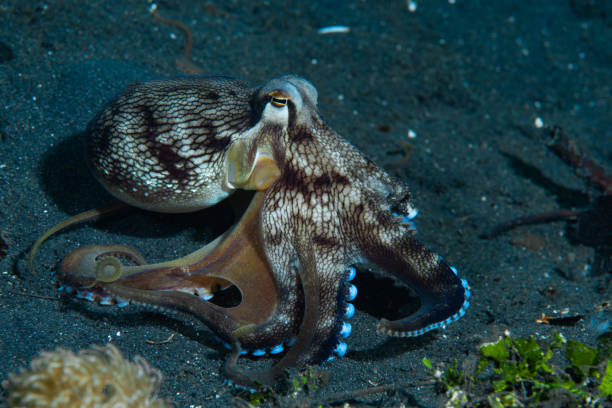Table of Contents
Scientific Classification
| Kingdom | Animalia |
| Phylum | Mollusca |
| Class | Cephalopoda |
| Order | Octopoda |
| Family | Octopodidae |
| Genus | Amphioctopus |
| Species | Amphioctopus marginatus |
| Scientific Name | Amphioctopus marginatus |
1. Description
The Coconut Octopus, known scientifically as Amphioctopus marginatus, is truly a remarkable creature when it comes to intelligence and adaptability. It has a compact mantle that measures about 3 inches in length, while its arms can stretch anywhere from 6 to 10 inches. With a soft, rounded body adorned in shades of brown, gray, or purplish hues, it also features pale, irregular markings and distinct banding on its arms. Its two large eyes are positioned high on its head, always on the lookout for anything happening around it.
What makes this species particularly intriguing is its behavior. The Coconut Octopus cleverly uses coconut shells and seashells as portable homes, which is how it earned its name. This behavior is one of the rare instances of tool use observed in invertebrates, showcasing just how fascinating these creatures can be!
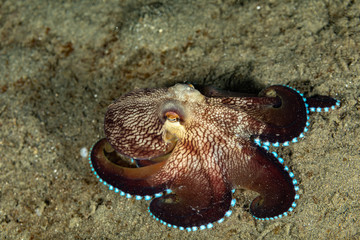
2. Distribution
The Coconut Octopus primarily inhabits the warm waters of the western Pacific and Indian Oceans. Its range begins in northern Australia and Indonesia, stretching through the Philippines and reaching into various parts of Southeast Asia. This fascinating creature heavily depends on coconut shells, marine debris, and the type of sediment found on the seafloor for its habitat and behavior.
3. Habitat
These flat seascapes provide little shelter. So, the octopus makes a “portable home” from coconut shells or bivalve halves. It often scuttles along the seafloor on two legs, like a waddling crab, while carrying its protective items.
These habitats are not only homes but also ambush zones. The octopus hides in the sediment, leaving just its eyes visible. It waits to pounce on unsuspecting prey.

4. Diet
The Coconut Octopus, being a true carnivore, has quite the diverse palate. Its meals primarily include:
– Crabs
– Shrimp
– Small fish
– Clams and other mollusks
This octopus is a masterful hunter, skillfully using its tentacles to capture its prey. With its powerful, parrot-like beak, it can crack open the tough shells of crustaceans or inject venom that breaks down its prey from the inside out. Plus, it has a nifty trick up its sleeve: it can shoot jets of water from its siphon to reveal hidden creatures lurking in the sand.
5. Behavior
The Coconut Octopus truly stands out as a remarkable creature in the cephalopod family. It showcases a variety of impressive behaviors:
Tool Use
This clever octopus gathers coconut shells and other bits of debris to create temporary homes. Sometimes, it cleverly fits two halves together and hides inside, crafting a makeshift “clamshell” for protection.
Bipedal Locomotion
With just two of its arms, it can stroll along the ocean floor while using the others to carry its portable shelter. This crab-like walking style is quite rare and really showcases its exceptional motor skills.
Mimicry and Camouflage
When danger approaches, it can swiftly alter its color and texture, allowing it to blend seamlessly into the sand, rocks, or coral. This incredible ability makes it nearly invisible to both predators and prey.
Burrowing
When it’s not toting a shell, the octopus often burrows into the sand, helping it to camouflage and stay safe.
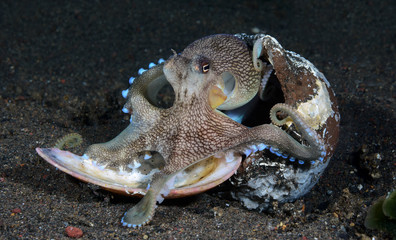
6. Lifespan
The Coconut Octopus, much like its fellow cephalopods, has a pretty brief lifespan, typically living around 1 to 2 years. Even though they’re known for their intelligence and intricate behaviors, octopuses tend to live fast and die young. Their lives are packed with learning, growing, mating, and ultimately passing on their genes in a whirlwind of activity, all within a short but vibrant existence.
7. Reproduction and Lifecycle
When it comes to Coconut Octopuses, their reproduction is quite a touching process. Males have a unique arm called a hectocotylus, which they use to pass a packet of sperm, known as a spermatophore, to the female. Interestingly, many males meet their end shortly after mating.
Females lay anywhere from hundreds to thousands of small, oval-shaped eggs in a safe spot, like a den or a coconut shell. They guard these eggs with fierce dedication, refusing to eat and constantly cleaning them with water. They also make sure to aerate the eggs regularly. Once the eggs hatch, the female typically dies, having fulfilled her purpose in life.
The hatchlings may be tiny, but they’re ready to fend for themselves. They enter a planktonic stage, drifting in the ocean for several weeks before settling on the seabed to begin their solitary journey.
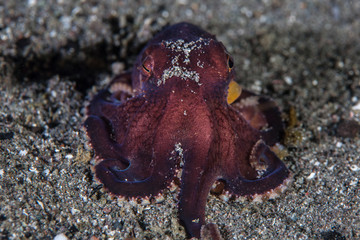
8. Predators
Even though the Coconut Octopus is quite resourceful, it still has to watch out for a variety of marine predators, such as:
– Sharks
– Bigger fish like groupers and moray eels
– Humans (indirectly, due to habitat destruction)
When it comes to defending itself, this clever octopus relies on its ability to escape and hide. It uses its quick reflexes, releases ink clouds, and employs camouflage to dodge danger. Plus, its habit of carrying a shell offers an extra layer of protection against those predators.
9. Adaptations
The Coconut Octopus has an incredible knack for survival, thanks to its remarkable ability to adapt:
Intelligence
Regarded as one of the brightest invertebrates, it showcases impressive problem-solving skills. Plus, it boasts a strong spatial memory and learns by watching others.
Shell Use
Using coconut shells isn’t just adorable—it’s also a smart survival tactic. The shell acts as a shield against predators and can even be used as a tool to catch unsuspecting prey.
Color and Texture Change
With the help of chromatophores in its skin, it can swiftly alter its color and texture. This skill is perfect for blending in and staying hidden.
Jet Propulsion
When faced with danger, it can make a quick getaway by forcefully expelling water from its siphon, propelling itself like a jet engine beneath the waves.
10. Conservation Status
- Right now, the Coconut Octopus isn’t classified as endangered or threatened. The IUCN (International Union for Conservation of Nature) hasn’t evaluated this species individually. Fortunately, it seems to do well in areas where fishing is moderate and human activity is limited.
- That said, there are still some threats to be aware of:
- Pollution: Marine debris and microplastics can really mess with their habitats. Interestingly, while these octopuses might use litter for shelter, too much pollution can harm the ecosystems they rely on.
- Bycatch: These octopuses aren’t the main catch for fishermen. Trawlers and small-scale fishers might accidentally catch them while targeting other fish.
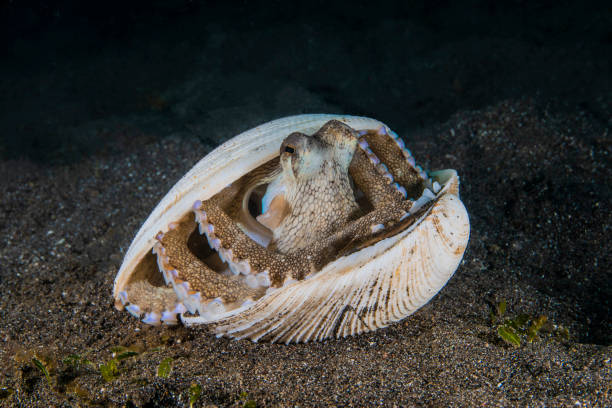
Final Thoughts
The Coconut Octopus may be small, but it certainly makes a big impact. Its clever behavior, quirky characteristics, and unusual shell habits remind us that intelligence isn’t just a trait of humans or mammals. This incredible creature highlights how complex and captivating ocean life truly is. Whether it’s strutting around on two legs along the ocean floor or crafting a cozy home from a coconut, it sparks our imagination.
Its tale serves as a reminder of the hidden marvels that lie beneath the waves. It also emphasizes the importance of caring for the seas that support these amazing beings.


